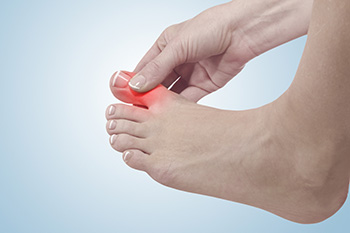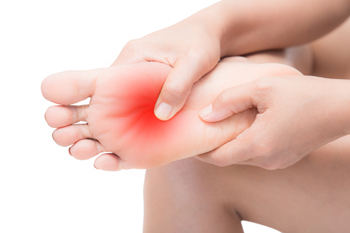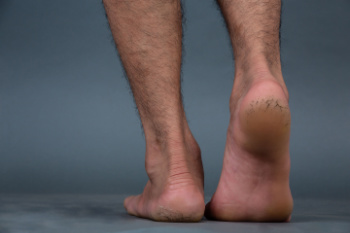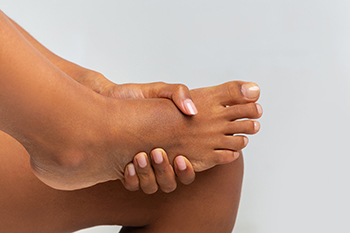Items filtered by date: May 2025
Understanding the Differences Between Gout and Bunions

Gout and bunions can both cause pain in the big toe, but they differ in onset, causes, and appearance. Gout is a form of arthritis that comes on suddenly, often overnight, causing intense pain, redness, and swelling, usually in the big toe. It is caused by a buildup of uric acid crystals in the joint, often linked to diet, alcohol, or genetics. Bunions develop gradually. They appear as a bony bump on the side of the big toe joint and result from structural issues, wearing tight shoes, or inherited foot shapes. A bunion may ache and swell as the top of the big toe turns inward over time. A podiatrist can diagnose each condition through exams, imaging, and testing. For gout, they may prescribe medication and offer dietary guidance. For bunions, treatment ranges from padding, orthotics, and anti-inflammatory meds to surgery, in severe cases. If you have this type of toe pain, it is suggested that you schedule an appointment with a podiatrist for appropriate treatment.
Gout is a foot condition that requires certain treatment and care. If you are seeking treatment, contact Donovan Gowdie, DPM from The Foot & Ankle Treatment Center. Our doctor will treat your foot and ankle needs.
What Is Gout?
Gout is a type of arthritis caused by a buildup of uric acid in the bloodstream. It often develops in the foot, especially the big toe area, although it can manifest in other parts of the body as well. Gout can make walking and standing very painful and is especially common in diabetics and the obese.
People typically get gout because of a poor diet. Genetic predisposition is also a factor. The children of parents who have had gout frequently have a chance of developing it themselves.
Gout can easily be identified by redness and inflammation of the big toe and the surrounding areas of the foot. Other symptoms include extreme fatigue, joint pain, and running high fevers. Sometimes corticosteroid drugs can be prescribed to treat gout, but the best way to combat this disease is to get more exercise and eat a better diet.
If you have any questions, please feel free to contact our office located in Watkinsville, GA . We offer the newest diagnostic and treatment technologies for all your foot care needs.
When Nerves Start to Fail the Feet

Diabetic neuropathy is a nerve condition that affects many people with diabetes, often starting in the feet. It develops slowly, causing numbness, tingling or burning that may feel worse at night. Because the nerves are damaged, it becomes harder to feel injuries, heat, or pressure. This loss of sensation puts the feet at greater risk for cuts, blisters, and infections that can go unnoticed and untreated. Over time, even small problems can lead to serious complications. Good blood sugar control, daily foot checks, and wearing supportive footwear can help manage symptoms and prevent injury. Some people also benefit from medication to ease nerve discomfort. If your feet feel different or you have diabetes and notice changes in sensation, it is suggested you see a podiatrist for a diagnosis and appropriate treatment.
Diabetic foot care is important in preventing foot ailments such as ulcers. If you are suffering from diabetes or have any other concerns about your feet, contact Donovan Gowdie, DPM from The Foot & Ankle Treatment Center. Our doctor can provide the care you need to keep you pain-free and on your feet.
Diabetic Foot Care
Diabetes affects millions of people every year. The condition can damage blood vessels in many parts of the body, especially the feet. Because of this, taking care of your feet is essential if you have diabetes, and having a podiatrist help monitor your foot health is highly recommended.
The Importance of Caring for Your Feet
- Routinely inspect your feet for bruises or sores.
- Wear socks that fit your feet comfortably.
- Wear comfortable shoes that provide adequate support.
Patients with diabetes should have their doctor monitor their blood levels, as blood sugar levels play such a huge role in diabetic care. Monitoring these levels on a regular basis is highly advised.
It is always best to inform your healthcare professional of any concerns you may have regarding your feet, especially for diabetic patients. Early treatment and routine foot examinations are keys to maintaining proper health, especially because severe complications can arise if proper treatment is not applied.
If you have any questions, please feel free to contact our office located in Watkinsville, GA . We offer the newest diagnostic and treatment technologies for all your foot care needs.
Cracked Heels and Their Common Causes

Cracked heels, also known as heel fissures, are a common foot condition where the skin surrounding the heel becomes dry, thick, and begins to split. This often occurs when the skin loses moisture and elasticity, leading to roughness and the development of painful cracks. One major cause is having naturally dry feet, which can worsen without proper moisturizing. Standing for long periods of time, especially on hard surfaces, puts constant pressure on the heels and can lead to skin breakdown. Dehydration reduces the skin’s ability to stay soft and flexible, increasing the risk of cracks. Additionally, being overweight can also add extra stress to the heel area, causing the skin to expand and split. Cracked heels may become painful, causing difficulty in completing daily tasks. If you have developed this condition, it is suggested that you contact a podiatrist who can offer effective treatment solutions, which may include prescribed medication.
Cracked heels are unsightly and can cause further damage to your shoes and feet. If you have any concerns, contact Donovan Gowdie, DPM from The Foot & Ankle Treatment Center. Our doctor can provide the care you need to keep you pain-free and on your feet.
Cracked Heels
Cracked heels appear unappealing and can make it harder for you walk around in sandals. Aside from looking unpleasant, cracked heels can also tear stockings, socks, and wear out your shoes. There are several methods to help restore a cracked heel and prevent further damage.
How Do You Get Them?
Dry skin is the number one culprit in creating cracked heels. Many athletes, walkers, joggers, and even swimmers suffer from cracked heels. Age and skin oil production play a role to getting cracked heels as well.
Promote Healing
Over the counter medicines can help, especially for those that need instant relief or who suffer from chronic dry feet.
Wear Socks – Wearing socks with medicated creams helps lock in moisture.
Moisturizers – Applying both day and night will help alleviate dryness which causes cracking.
Pumice Stones – These exfoliate and remove dead skin, which allows for smoother moisturizer application and better absorption into the skin.
Change in Diet
Eating healthy with a well-balanced diet will give the skin a fresh and radiant look. Your body responds to the kinds of food you ingest. Omega-3 fatty acids and zinc supplements can also revitalize skin tissue.
Most importantly, seek professional help if unsure how to proceed in treating cracked heels. A podiatrist will help you with any questions or information needed.
If you have any questions, please feel free to contact our office located in Watkinsville, GA . We offer the newest diagnostic and treatment technologies for all your foot care needs.
Managing Foot Cramps

Foot cramps are sudden, involuntary muscle spasms that can cause sharp, intense pain in the feet or toes. These cramps can last from a few seconds to several minutes, and may feel like the muscles are tight, knotted, or twitching. Common causes include physical activity, prolonged standing, dehydration, medication side effects, or underlying health conditions like nerve issues or circulation problems. Poorly fitting shoes and lack of support can also trigger foot cramps, especially during exercise or at night. While most cramps go away with gentle stretching, massaging, or walking, frequent or severe cramps may signal an underlying issue. A podiatrist can assess your symptoms, review your medical history, and recommend proper footwear, orthotics, stretching routines, or hydration strategies. They may also evaluate for circulatory or nerve-related causes and suggest treatments accordingly. If you have foot cramps, it is suggested that you schedule an appointment to see a podiatrist.
Foot Pain
Foot pain can be extremely painful and debilitating. If you have a foot pain, consult with Donovan Gowdie, DPM from The Foot & Ankle Treatment Center. Our doctor will assess your condition and provide you with quality foot and ankle treatment.
Causes
Foot pain is a very broad condition that could be caused by one or more ailments. The most common include:
- Bunions
- Hammertoes
- Plantar Fasciitis
- Bone Spurs
- Corns
- Tarsal Tunnel Syndrome
- Ingrown Toenails
- Arthritis (such as Gout, Rheumatoid, and Osteoarthritis)
- Flat Feet
- Injury (from stress fractures, broken toe, foot, ankle, Achilles tendon ruptures, and sprains)
- And more
Diagnosis
To figure out the cause of foot pain, podiatrists utilize several different methods. This can range from simple visual inspections and sensation tests to X-rays and MRI scans. Prior medical history, family medical history, and any recent physical traumatic events will all be taken into consideration for a proper diagnosis.
Treatment
Treatment depends upon the cause of the foot pain. Whether it is resting, staying off the foot, or having surgery; podiatrists have a number of treatment options available for foot pain.
If you have any questions, please feel free to contact our office located in Watkinsville, GA . We offer the newest diagnostic and treatment technologies for all your foot care needs.

